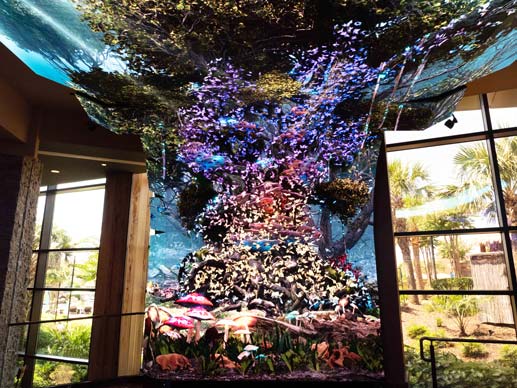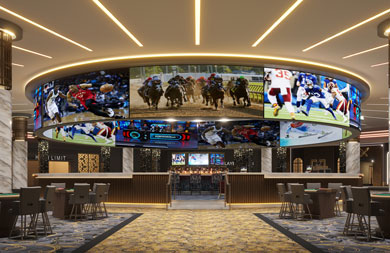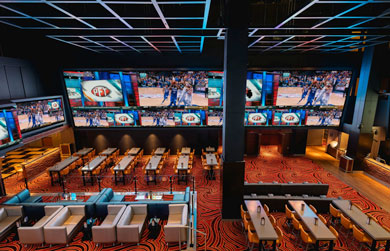 The Link at Choctaw Casino & Resort (Photo credit: Joe Cantu)
The Link at Choctaw Casino & Resort (Photo credit: Joe Cantu) The video wall at Choctaw Casino & Resort changes with the hours of the day, deepening from daylight to dusk to nightfall, and also changing with the seasons.
The attraction called the Link features a setting of flora, fauna and fantasy, including true-to-life woodland creatures who casually come and go from the glen, drawing viewers into their digital world. Animals and other features rise unexpectedly, leaving visitors with a sense of wonder and an eagerness to see more.
Conceptualized as a “living” attraction, the Link takes digital entertainment to the nth degree, technology-wise. Since its launch in 2020 at the Durant, Oklahoma tribal resort, it has become a stand-alone destination, the latest iteration of attractions like the fountains at the Bellagio in Las Vegas.
“The Link serves as the resort’s digital response to other well-known gaming industry art installations,” says Dave Kubajak, senior vice president of sales for JCM Global, which designed and installed the attraction in collaboration with Meld Strategy and Creative. “It also serves as a bridge between the two large gaming floors.”
Signs of the Times
For decades, Times Square in New York City showed the world how to use video walls to make a statement, in the form of giant billboards. Who wasn’t mesmerized to see the Marlboro Man blowing smoke into the air from above, or the Camel man doing the same? OK, maybe that was a bad look. But it was an innovative one.
Today’s video walls—bigger, splashier and more interactive than ever—also took a cue from a humble concept: TV screens at sports bars and sportsbooks.
Just a few years ago, sportsbooks were a rarity outside Las Vegas. But sports bars were a thing, and they usually featured an array of televisions plastered around the room, almost all showcasing a different game. They were, in fact, rudimentary video walls, with a pulse on the future.
In 2018, after the U.S. Supreme Court struck down the federal law prohibiting sports betting, Atlantic City casinos started adding sportsbooks. That’s when designers saw the potential of video walls and how they could evolve beyond a bank of TV screens. “As technology advanced, so did our design perspective in order to stay ahead of the latest trends,” says Michael Mangini, director of design for SOSH Architects.
Multimedia walls became more than just a way to broadcast a baseball or basketball game while customers imbibed a beer or three. They became a source of entertainment—not just in sportsbooks and sports bars, but in retail clothing boutiques, health care centers, corporate boardrooms, and any businesses that saw an opportunity to make a statement, and had the means to do so.

Video wall at Terre Haute Casino & Resort by R2Architects, to open in 2024
New Jersey-based R2Architects designed a video feature, now under construction, for Terre Haute Casino and Resort in Indiana. “You’ll see it in the center of the casino, a two-sided video wall,” says John P. Ruiz, who is principal of R2A, along with David J. Rudzenski. The wall involves huge circular screens inside and outside a bar on the casino floor, and features a 60-foot diameter video wall, up to eight feet tall, inboard and outboard.
It displays sporting events at multiple venues, “intermixed with property promotions and shows, in tandem with music video content as well,” says Ruiz. “Around the circumference on the ring you’re seeing a variety of different content.”
At All Costs
The investment level for video walls has “come down in 10 years, but is still expensive,” Ruiz adds. “A small four-by-10-foot wall could cost up to the $100,000 range. Larger ones have a $1 million budget. If you want higher clarity, you spend more money.”
Video walls have become an integral part of design, rather than an afterthought. And large-format videos that evoke emotion and feedback can be pretty spectacular. Take the famous Fremont Street Experience in Downtown Las Vegas, which was credited with bringing traffic back to the city that had left for the Strip. Or the video wall at Harrah’s Atlantic City, which covers the whole side of the 46-story building, and promotes upcoming concerts and other special events, and can be seen from miles away.
“There’s a true science to creating the right ratio of curated media content and pixel resolution to the distance in which the end-user is viewing it,” says Mangini. “We’re fortunate to work with some truly talented audio-visual and acoustical consultants that specialize in this area.”
If the space is more intimate and guests view the screens up close, finer resolution is essential. From a distance, less resolution is needed. Designers must also weigh lighting to create an immersive viewing experience. Consumers are increasingly sophisticated about digital entertainment, so when a property invests in a digital display, quality must be top of mind.
“We work with clients that don’t have budgets to accommodate huge video walls but still want an AV experience that we can creatively deliver,” Mangini says. “Though as technology becomes more affordable, we anticipate seeing more of the TVs currently being used in those venues replaced with video walls. There are no boundaries if your imagination, creativity and budget help guide the design decisions.”

 William Hill Sportsbook at Tropicana Atlantic City (Photo credit: Dinofa Photography)
SOSH designs include the Gallery at the Ocean Casino Resort in Atlantic City, which features three massive custom direct-view LED video walls; and the William Hill Sportsbook at Tropicana, also in AC, which includes more than 1,654 square feet of 2.6 mm pixel pitched LED screens.
“Bigger is often better,” Mangini says, “and you can deliver more content with versatility, whether it’s one large Super Bowl party or basketball tournaments with 20 games being shown at once.”
Sound Decisions
On the auditory side, operators have the ability to control the content they want. “We often consider audio sound isolation when creating multiple viewing areas,” Mangini says. “This is where an invisible audio cone of sound isolation is established for a specific seating area.
“People outside this area cannot hear the audio well as opposed to the people inside the area of the invisible audio cone. We can establish multiple AV and audio zones where different groups can experience different games without interfering with one another.”
At the Desert Diamond West Valley Casino in Glendale, Arizona, JCM installed a broad range of digital signage, from the sports bar to the bingo room to the poker room.
“At the sports bar, guests enjoy the action on five giant LED video walls for the ultimate sports viewing party,” says Kubajak. “The poker room features 16 LCD displays suspended from the ceiling in unique pod configurations, giving players the ability to enjoy a game of poker without missing the action of any broadcasted sporting event.
“Additionally, in the bingo room, a 16.4-foot-by-11.4-foot LED video wall displays all the bingo fun, along with a variety of live programming for added entertainment.”
The R2A-designed video wall at Oak Grove Racing Gaming and Hotel in Oak Grove, Kentucky rises three feet above the casino floor behind a bar. A band plays from a stage behind the bartender, and the video wall lays behind the band.
“A lot of times customers want to outdo themselves and use digital signage as an opportunity to refresh and update the property,” Kubajak says. “For example, we recently installed our largest-ever sports ticker: a DSS FLEX LITE-S 1.9 mm ticker measuring 96 feet wide by nearly two feet high at Jack Thistledown Racino in Ohio.”
From Subtle to Spectacular
The casino floor at Resorts World Catskills features a dynamic installation with water that “bounces” off whatever it hits at the bottom of the screen. At the center of the video wall, a hydraulic door opens to a small stage and causes the water to “crash” into the door frame while it’s visible. It creates an incredible, relaxing experience for guests to enjoy while they sit in the bar area.
Another example of an extravagant outdoor display is at Grand Casino in Shawnee, Oklahoma, where JCM installed a 10-mm Mitsubishi NXL Series double-sided digital sign that measures nearly 40 feet wide and 20 feet tall on both sides. It’s mounted within an existing pylon sign frame structure at the property’s entrance and greets guests with a variety of messaging.
“The sportsbooks we originally designed five years ago are utilizing AV consultants to update their processing capabilities to deliver the best quality viewing experience for their customers,” says Kubajak.
Some operators prefer subtlety over spectacle, or want to strike a balance between the two. “It’s important to be considerate of the client and end user, what their expectations are and what you’re trying to achieve through design,” says Mangini. “Spectacular isn’t necessarily the right fit for a piano bar or intimate lounge setting, while a high-energy sports bar or outdoor arena necessitates more of a dramatic design approach.”
Whether reorganizing or designing something new, it’s necessary to not only appeal to the client but factor in the space and the budget. “In a small space, we’re mindful not to overload every wall and instead be focus-driven on what will create the best immersive experience,” says Mangini. “Each space and client has its own unique set of requirements in terms of what they’re trying to achieve.”
Outside the gaming realm, the trend of immersive art exhibits in media and AV are intended to be highly sensory and their popularity is sparking similar exhibits to pop up.
“Immersive is good and creates an opportunity to push the envelope of using technology as a way to create and enhance unique guest experiences, while also taking into consideration the end user and what the client wants to achieve,” says Mangini.
Million-dollar shows are always fun to design, especially when they’re focused and have a purpose, he adds. “Spectacular spaces can be impactful and memorable when they’re designed for the right environment.”





